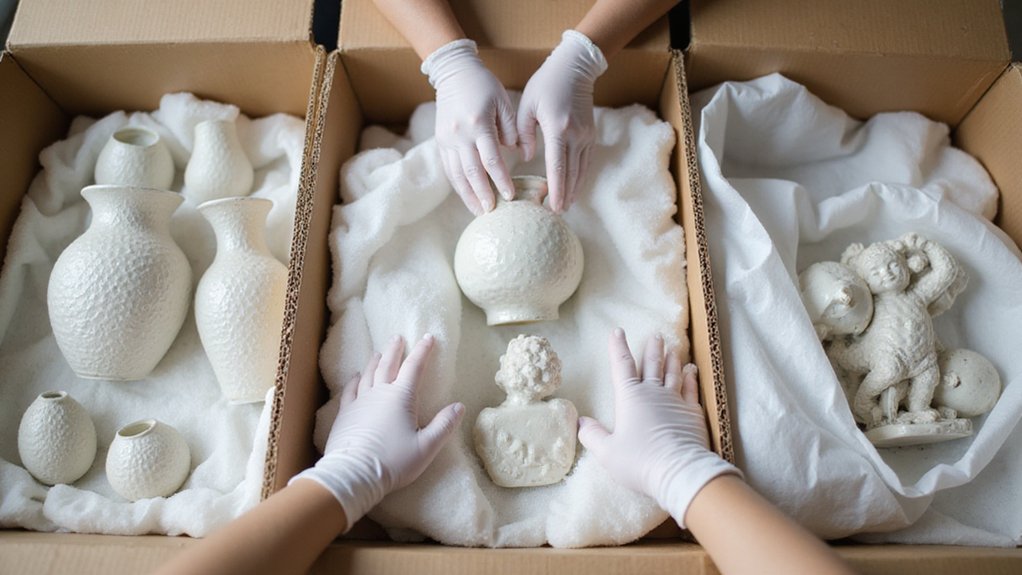Moving day can quickly turn stressful when fragile items are at risk of damage. You'll want to protect your most delicate possessions from potential disaster, and that starts with smart packing strategies. Whether you're moving cherished family heirlooms or expensive electronics, the right technique can mean the difference between safe arrival and heartbreaking breakage. What secrets will help you safeguard your prized possessions during transit? Stay tuned to uncover professional packing methods that can save your most cherished items from moving day mishaps.
Key Takeaways
- Use high-quality bubble wrap and packing paper to create multiple protective layers around each fragile item before boxing.
- Select sturdy, appropriately-sized boxes and fill empty spaces with cushioning materials to prevent shifting during transportation.
- Place heavier fragile objects at the bottom of boxes and distribute weight evenly to minimize potential impact damage.
- Wrap individual delicate items separately, ensuring no direct contact between breakable objects that could cause mutual damage.
- Label boxes containing fragile items clearly with "FRAGILE" and "Handle with Care" to alert movers and handlers.
Essential Packing Materials for Fragile Items
How do you guarantee your delicate items arrive safely during a move? You'll need suitable cushioning materials and proper storage containers to protect fragile belongings. Bubble wrap, packing paper, foam sheets, and sturdy cardboard boxes are essential for preventing breakage.
You'll want to carefully wrap each item individually, creating a protective barrier that absorbs shock during transportation. Choose boxes that match your items' sizes, ensuring a snug fit that minimizes movement. By investing in quality packing supplies and taking time to wrap carefully, you'll greatly reduce the risk of damage and enjoy peace of mind during your move. Professional movers with specialized equipment can also provide additional guidance and support for safely transporting delicate items during a move.
Wrapping Techniques for Different Types of Delicate Objects
While each delicate item requires unique protection, commanding specific wrapping techniques can save you from potential moving day heartbreak.
For proper storage of glassware, wrap each piece individually in bubble wrap, securing the edges with packing tape. Cushion these items with additional padding inside sturdy boxes.
When securing small trinkets, use soft tissue paper or specialized foam pouches to prevent movement and scratching.
Fragile ceramics, sculptures, and collectibles need extra attention—layer them carefully, ensuring no exposed surfaces can impact during transit.
Your careful wrapping will protect your precious memories and prized possessions. Fully secure facilities offer additional peace of mind for your most delicate belongings during storage and moving.
Strategic Boxing and Cushioning Methods
Because proper boxing and cushioning can mean the difference between intact and shattered belongings, selecting the right containers and protective materials becomes essential for secure transportation. You'll want to choose sturdy boxes with ideal container dimensions that match your items' sizes precisely.
Follow a proper packing order: place heavier objects at the bottom and lighter, more delicate items on top. Use bubble wrap, packing paper, or foam cushioning between each fragile piece. Fill empty spaces with additional padding to prevent shifting during movement.
Your meticulous approach will help guarantee your cherished items arrive safely at their destination.
Protecting Electronics and Sensitive Equipment
After carefully cushioning fragile china and artwork, safeguarding electronic devices requires equally strategic preparation. You'll want to wrap computers, tablets, and cameras in anti-static bubble wrap to prevent electrical damage.
Consider climate control needs during transportation, especially for sensitive equipment like professional cameras or music gear. Pack backup power sources separately and cushion them individually. Secure loose cables with twist ties and place each device in a padded, rigid container.
Label boxes as "Fragile Electronics" to guarantee careful handling. Padding, protection, and careful planning will help your precious tech survive the excursion intact.
Handling Valuable and Sentimental Breakables
When it comes to packing irreplaceable family heirlooms and cherished keepsakes, you'll need a precise approach that combines protection and emotional care. Heirloom china preservation requires specialized materials like bubble wrap, cushioned containers, and acid-free tissue paper.
Handle fragile family memorabilia with gentle hands, wrapping each piece individually and creating protective layers between items. Mark boxes with "FRAGILE" and "Handle with Care" to alert movers.
Opt to transport extremely precious items personally to safeguard their safety. Take your time, be methodical, and remember that careful packing can protect your most meaningful possessions during a move.
Labeling and Organizing Fragile Packages
Proper labeling and organization can make the difference between a smooth move and a disastrous one when it comes to fragile items. You'll want to use color-coded stickers or markers to quickly identify which boxes contain breakables.
Place these packages with high placement priority in the moving truck, keeping them away from heavy items that could crush them. Consider using bright red or orange labels that scream "FRAGILE" to catch movers' attention.
Loading and Transport Best Practices for Delicate Items
Once you've carefully packed your fragile items, it's vital to strategically load and transport them to minimize the risk of damage.
When loading your delicate belongings, place heavier boxes at the bottom and lighter, fragile boxes on top. Use proper loading procedures to distribute weight evenly and prevent shifting during transit. Secure each box with packing tape and use bubble wrap or foam padding between items.
When driving, take smooth, gentle routes and avoid sudden stops or sharp turns that could cause items to jostle. Ensuring load during transit is paramount to protecting your precious possessions.
Frequently Asked Questions
Can I Use Newspaper to Wrap Fragile Items Instead of Bubble Wrap?
You can use newspaper, but it's not ideal for delicate packing techniques. Bubble wrap offers better protection, while newspaper might scratch or leave ink marks on your fragile item alternatives during transit.
How Long Does Bubble Wrap Protection Last During a Move?
You'll find bubble wrap's protection typically lasts one move, depending on its thickness. Your bubble wrap's durability depends on handling, storage conditions, and whether you're careful during transit.
Are Professional Movers Better at Handling Delicate Items Than Self-Moving?
Professional movers' extensive experience and proper packing techniques often surpass DIY methods. You'll gain peace of mind knowing experts handle your delicate items with precision, minimizing potential damage during transit.
What if an Item Breaks During the Moving Process?
If something breaks, you'll want to file a damage claim quickly. Buy insurance for precious items beforehand, documenting their condition. Your proactive approach protects your freedom to recover potential losses during the move.
How Expensive Are Specialized Fragile Item Packing Materials?
You'll find specialty packing supplies can be pricey, but cost effective alternatives like bubble wrap, newspaper, and foam sheets offer budget-friendly protection for your delicate items during moving.



